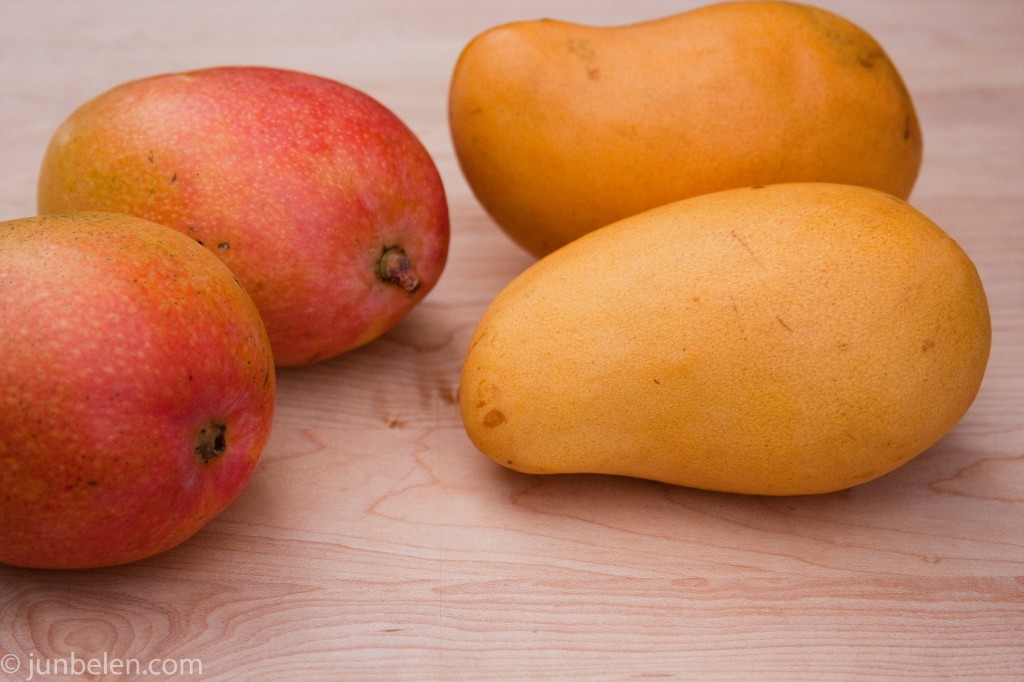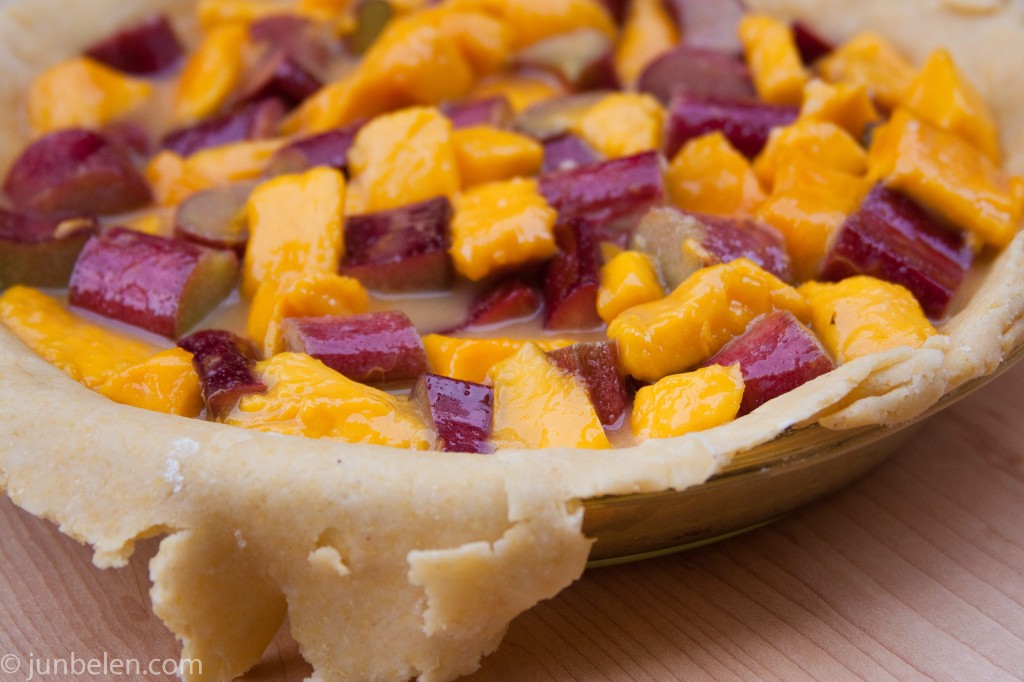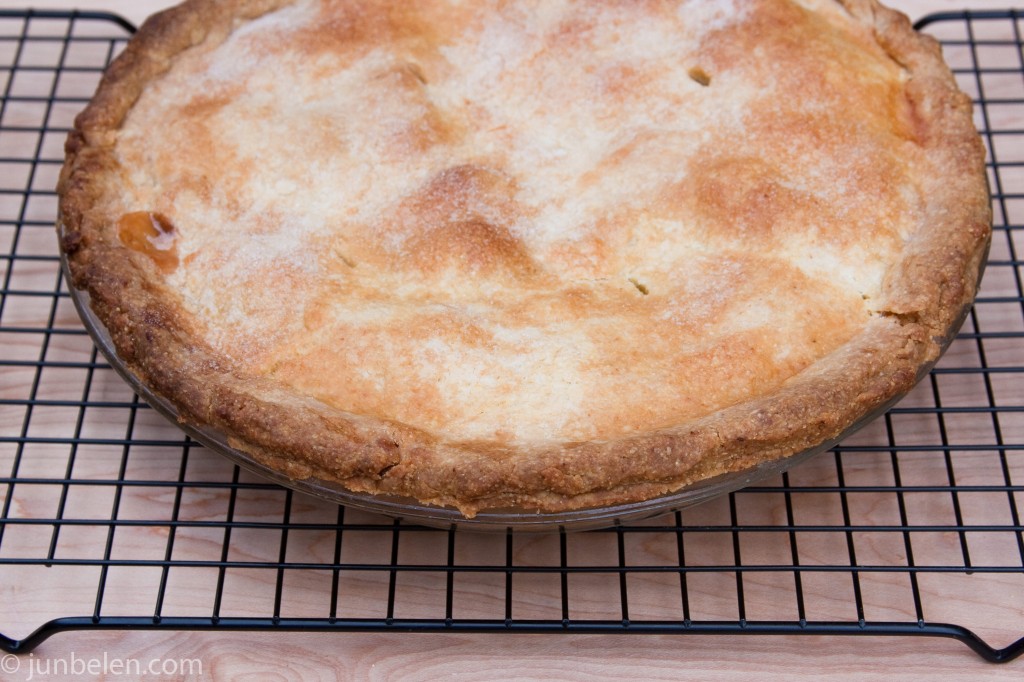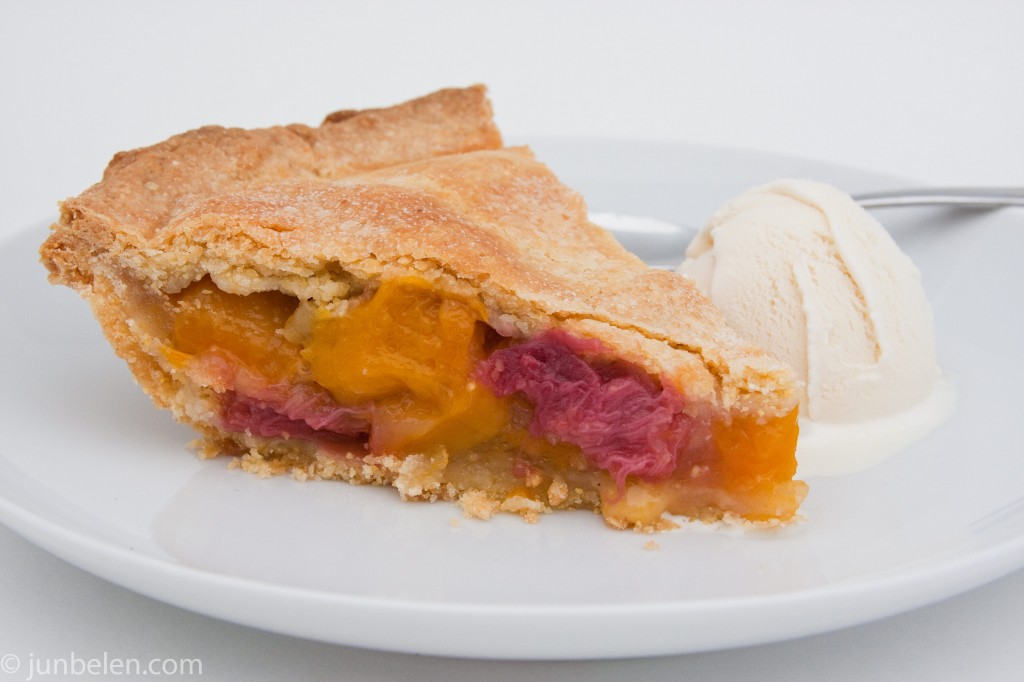I had planned to make mango rhubarb pie. All the gorgeous rhubarb pies that has flooded the blogosphere has made me crave for my own. I thought the sweetness of the champagne mangoes would wonderfully complement the tartness of the rhubarb stalks. And I thought the vibrant golden mango and red rhubarb colors would make a really pretty pie.
And so last Saturday, the plan was to shop for Mexico-grown champagne mangoes in the Mission after a trip to nearby Alemany Farmers’ Market. I was excited. But as soon as I unexpectedly spotted a big heap of champagne mangoes at Alemany, I drooled and then quickly wondered — are these for real, are these truly California-grown? A friendly chat with Andrea of Family Farm Foods confirmed it. She grows these sweet mangoes at her farm in Palmdale, northeast of Los Angeles. It’s a pretty long road trip to San Francisco, but I was so glad she made the journey Saturday morning.
Champagne mangoes are the closest to Philippine mangoes that I’ve seen here in California. Americans refer to them as Manila mangoes, honey mangoes, or Ataulfo mangoes (named after their Mexican grower). They’re large, oblong, and vaguely kidney-esque, turning a deep yellow-orange as they ripen. The golden flesh is soft, almost buttery, and very, very sweet. In contrast, the mangoes grown in Mexico and sold in most produce stores in the city are rounder, with a reddish-green color that turns reddish-orange as they ripen.
Shortly after my productive shopping spree at Alemany, I bought some rhubarb stalks and excitedly went home to make my own mango rhubarb pie. My recipe is based on the strawberry rhubarb pie recipe found in the . To add a wonderful crunch to the crust, I made a cornmeal pie crust.
Mango Rhubarb Pie with Cornmeal Crust Recipe
Recipe based on Irma Rombauer’s Strawberry Rhubarb Pie from The Joy of Cooking, makes one 9-inch pie
For the cornmeal pie crust, makes one 9- or 10-inch double crust
1-3/4 cups all-purpose flour
3/4 cup yellow cornmeal
1/3 cup confectioner’s sugar
1-1/4 tsp salt
3/4 cup chilled lard or vegetable shortening
3 Tbsp cold unsalted butter
6 Tbsp ice water
For the mango rhubarb filling
1 lb rhubarb stalks, cleaned and trimmed
2 large champagne mangoes
1 cup sugar
1/4 cup cornstarch or quick-cooking tapioca
1/4 tsp salt
2 Tbsp unsalted butter, cut into small pieces
1 Tbsp milk or cream
2 tsp sugar
Making the Dough
Sift together the flour, cornmeal, sugar and salt. Mix the chilled shortening and butter.
There are two steps in making pastry dough by hand. First, cut the fat into the dry ingredients and, second, bind the dough with water.
Cut half of the shortening mixture into the flour mixture with a pastry blender or work it in lightly with the tips of your fingers until it has the consistency of cornmeal. Work it in lightly and do not overwork the dough because it will become dense and greasy. Cut the second half of the shortening mixture into the dough until it is pea-sized. If you don’t have a pastry blender, you can use a fork. Leave it in firm, separate pieces, some fine and crumblike and the rest the size of peas.
Sprinkle the dough with ice water. Blend the water gently into the dough until it just holds together. You may lift the ingredients with a fork, allowing the moisture to spread. If necessary add another teaspoon to a tablespoon of ice water to hold the ingredients together. It is important to add only enough water to make the dough hold together but be careful not to put so much as to cause excessive gluten to develop, which would make the pie crust hard or chewy and breadlike. As a rule of thumb, the flour and fat mixture should be moistened only to the point where it forms small balls that hold together when pressed with your fingers.
Divide the dough in half, shape each into a disk, wrap in plastic wrap. and refrigerate. Chilling the dough up to 12 hours tenderizes it, helps keep it from shrinking during baking, and makes it easier to handle. If the dough has been chilled longer than 30 minutes, let it stand until it feels firm yet pliable, like modeling clay, when pressed. If it is too cold, the dough will crack around the edges when rolled.
Rolling the Dough
Roll the dough on a pastry cloth, pastry board, marble slab or on clean smooth countertop away from anything hot in your kitchen to avoid melting the fat. If the dough becomes too soft while rolling, loosen it from the work surface, slide a rimless cookie sheet beneath it, and refrigerate until it firms up.
Lightly flour the work surface and the dough. Roll the dough from the center out in all directions, stopping just short of the edge.
Check to make sure that the dough does not stick to the surface by sliding your hand beneath it. Scatter a little more flour on the work surface if it becomes too sticky. Rolling dough is like modeling clay. Seal cracks and splits by pushing the dough together with your fingers. Patch any holes, tears, or thin spots with dough scraps. Moisten one side with cold water and then firmly press them into place, with the moistened side down.
Shaping and Trimming the Dough
Roll the dough into a circle roughly 3 to 4 inches larger than your pan to allow plenty of dough for a rim. The best way to make sure that you rolled the right size is by inverting the pie pan and placing it in the center of the rolled dough. Transfer the rolled dough carefully into the pan and press it firmly into the pan. Trim the edges of the dough with a pair of scissors or a small pairing knife, leaving a 3/4-inch overhang.
Making the mango-rhubarb filling
Position a rack in the lower third of the oven. Preheat the oven to 425 degrees F.
Without peeling, cut the rhubarb stalks into 1-inch strips and measure 2-1/2 cups. Peel and cut the mangoes into 1- to 2-inch slices and measure 2-1/2 cups.
Combine the rhubarb, mango, sugar, cornstarch, and salt in a large bowl. Let it stand for 15 minutes, stirring occasionally. Pour the mango-rhubarb filling in the crust-lined pan and dot with butter.
Making the top crust
Roll the other half of the dough to make the solid top crust. Cut the rolled dough 1 inch larger than the pan.
Brush the overhang edge of the bottom crust with cold water. Place the top crust over the pie. Firmly pinch the edges of both crusts to seal. Trim the edge of both crusts to a 3/4-inch overhang then tuck the overhang underneath itself so that the folded edge is flush with the rim of the pie pan. To allow the steam to escape during baking, using a sharp paring knife, make three or four 2-inch vents in the top crust.
Lightly brush the top crust with milk or cream and sprinkle with sugar.
Bake for 30 minutes, then lower the heat to 350 degrees F and bake for 25 to 30 minutes more, until the juices are thick and bubbling. Cool completely on a rack.
I love my pies a la mode. A scoop of vanilla ice cream pairs very well with the sweetness and tartness of the pie. The cornmeal crust gives it a wonderful texture that is seriously indescribable.



